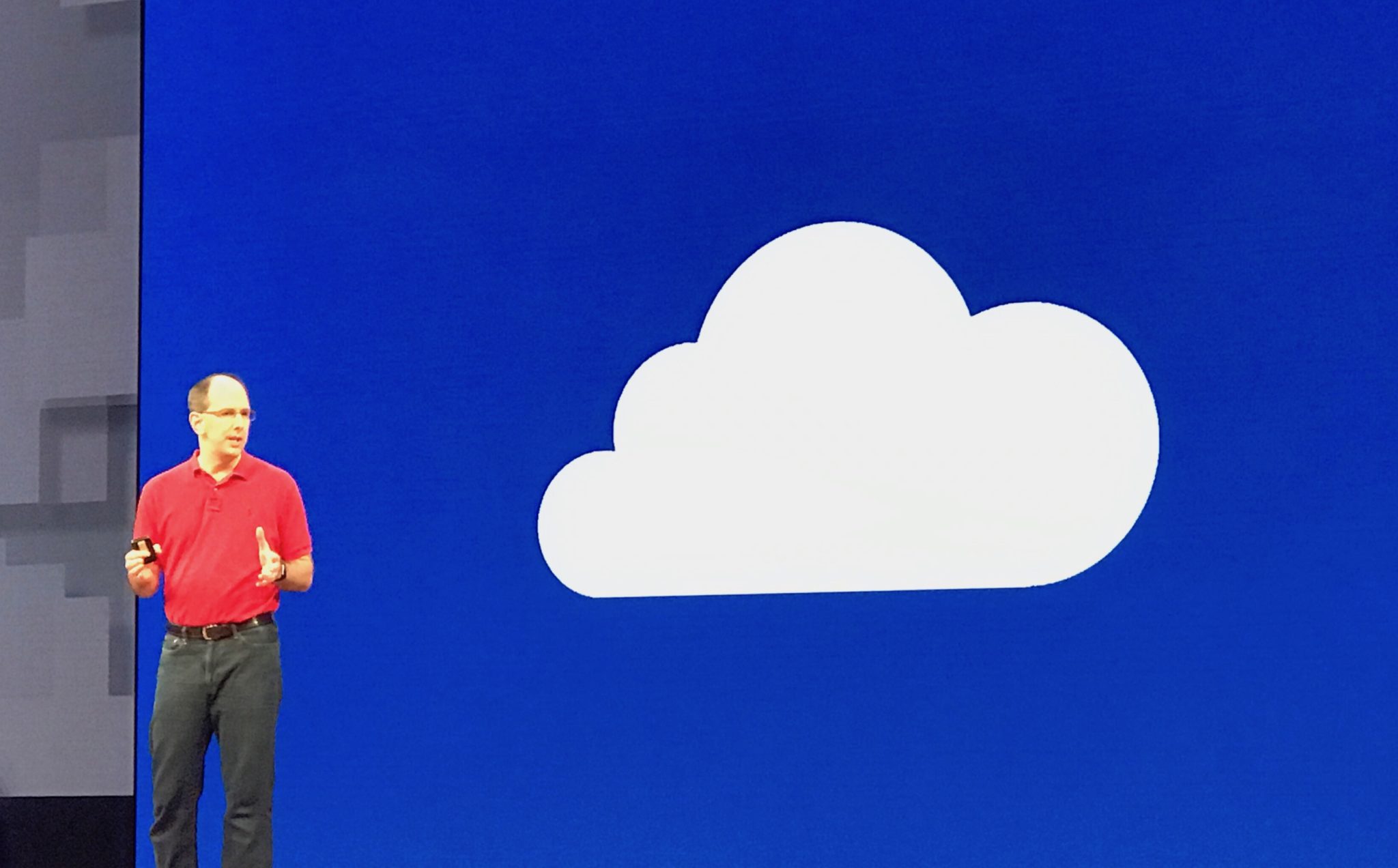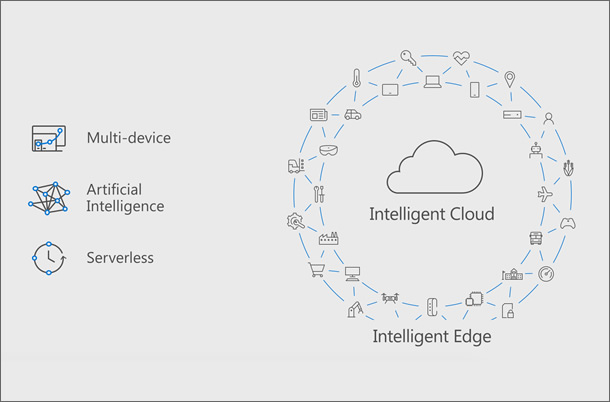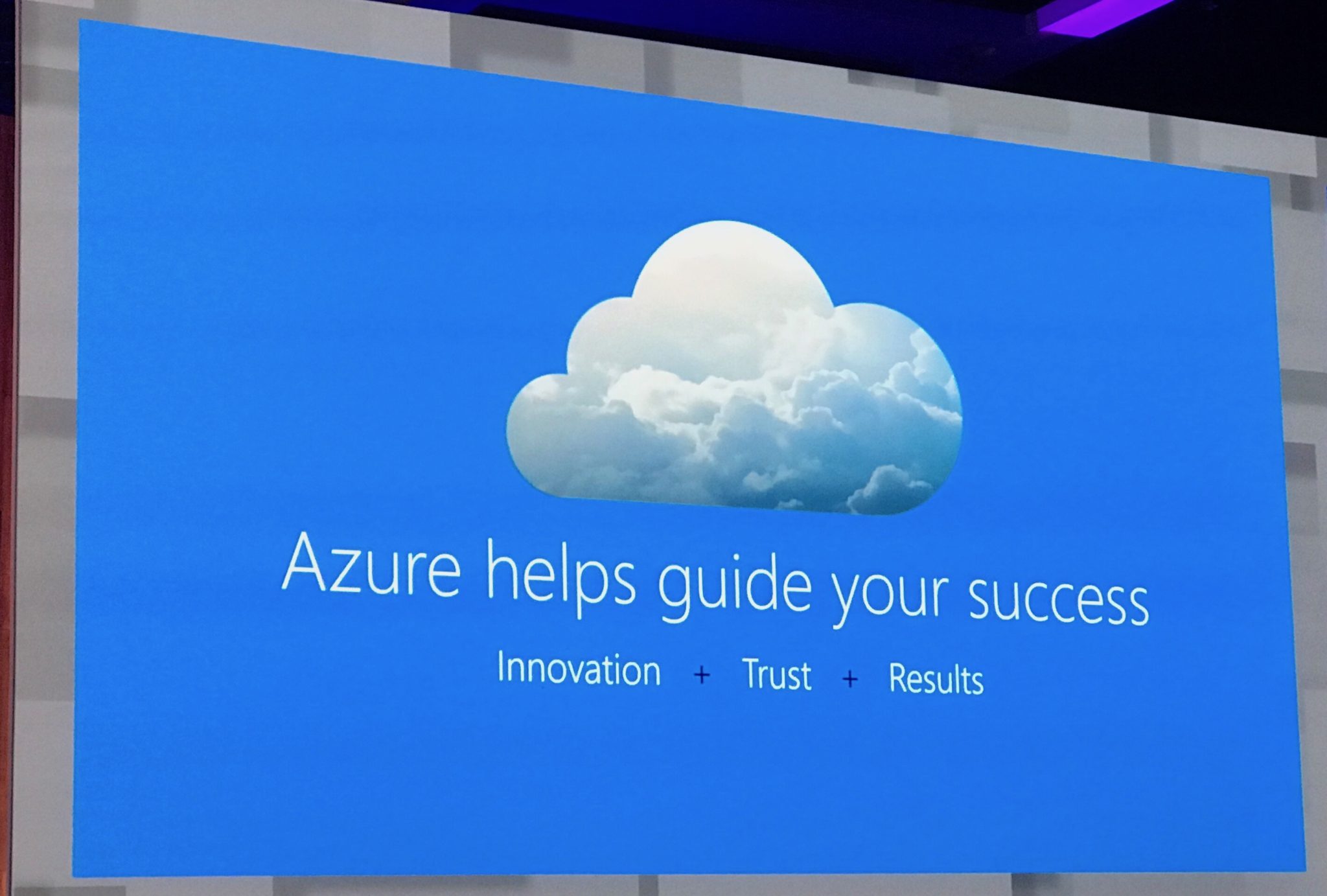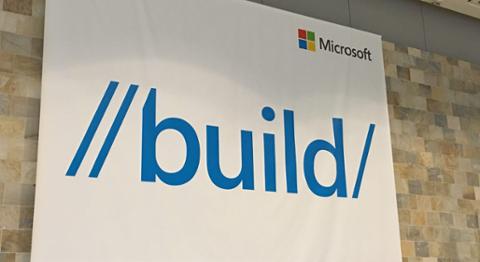[caption id="attachment_141606" align="aligncenter" width="3305"]

The Cloud at Build 2017[/caption] At this year's Build conference, Microsoft offered some interesting new tools for developers, but one theme was repetitive: "
Intelligent Cloud, Intelligent Edge." It’s a new conversation that Microsoft wants to have with users, but not a fresh concept. In a nutshell, "Intelligent Cloud, Intelligent Edge" is the latest manifestation of Microsoft’s longtime "Cloud First, Mobile First" theme. The "edge" represents devices and the data they produce. Microsoft says that data has “gravity,” and hopes to make its cloud the center of its users' every computer-related function. It’s really an aggressive push into better artificial intelligence (A.I.), and feels a lot like Apple’s Handoff and Continuation features (which let you pick up where you left off regardless of which device you’re on). For example: Microsoft's Cortana digital assistant, having become an A.I.-powered focal point, can peek into services such as your calendar to know you have a morning meeting. Using Bing’s maps data, Cortana knows traffic is a bit heavy and suggests you leave earlier than you planned. If you leave and find that traffic is at a standstill, Cortana offers to link you to the meeting remotely (since you clearly won’t make it), or call the other participants so you can tell them you’ll be late. If documents are shared in the meeting, you’d get those as well, possibly when you arrive at the office. It’s a touch of continuity laced with proactive A.I. [caption id="attachment_141608" align="aligncenter" width="610"]

Intelligent Edge, Intelligent Cloud[/caption] The problem? Microsoft has 500 million monthly active (MAU) Windows 10 users, but says Cortana has 140 MAUs. That puts Cortana usage at around 28 percent of Windows users; more to the point, that’s nearly three-fourths
not bothering with Cortana. An upside is that the Intelligent Edge doesn’t discriminate. Microsoft no longer sees a difference between an IoT sensor and your iPhone, and a PC isn't given preference over either. Data is data, and everything creates gravity for the company to make use of. So while devices are busy spitting out data points, they’re also communicating with one another, albeit lightly. The Intelligent Cloud wants to make those interactions deeper (such as Cortana monitoring traffic, knowing you won’t make it and offering to call your colleagues). It’s here where things get both exciting and tricky; the cloud is a big, mysterious monolith for most developers, even with a lot of tools. In that deep space of the cloud, Microsoft promises magic. Onstage at Build, CEO Satya Nadella said: “Serverless computation will change how we think about logic.” He went on to note that logic can’t be “bound and running,” but has to be more dynamic. All of this intelligence and gravity can “fundamentally change culture and work.” He’s speaking to a sense of responsibility that Microsoft wants developers to have about their work. Nadella thinks everything they create, from apps to algorithms, should be done with care. While he thinks people should be “empowered with technology,” he cautioned: “Building trust in technology is crucial.” “A sense of purpose is what’s been driving us in this mobile-first, cloud-first world,” he said. [caption id="attachment_141607" align="aligncenter" width="2841"]

Azure Cloud Trust[/caption] On paper, Microsoft is lining up big things. Azure Cosmos is an impressive always-on database service. Visual Studio for Mac and Windows is starting to round into shape. Graph is growing, and the bot framework now supports adaptive cards and work within Bing, Cortana and Skype for Business. In a strange way, Intelligent Edge and Intelligent Cloud signal critical mass. We’ve reached a high level of computational power, and every device and service produces tons of data. It’s now a matter of what to do with it all. For Microsoft, collecting and making sense of data also means accelerating its A.I. initiatives. No matter where you look in technology, A.I. is there. Siri, Cortana, Google, Alexa – they’re all central to their respective platforms or companies. Like Google and Apple, Microsoft wants to use its own generated data for A.I. Unlike those two, it wants developers deeply involved by asking them to filter everything through Azure. It’s also hoping to pull data from anywhere and make useful services for enterprise, where Microsoft is generally focused now. The Intelligent Edge means devices and services, but developers have to connect them to the cloud. It’s that virtual micro-interaction where Microsoft is also betting big; if it can get developers linking to Azure, data follows, and its A.I. improves. If not, the 28 percent of people using Cortana likely won’t have more company.
 The Cloud at Build 2017[/caption] At this year's Build conference, Microsoft offered some interesting new tools for developers, but one theme was repetitive: "Intelligent Cloud, Intelligent Edge." It’s a new conversation that Microsoft wants to have with users, but not a fresh concept. In a nutshell, "Intelligent Cloud, Intelligent Edge" is the latest manifestation of Microsoft’s longtime "Cloud First, Mobile First" theme. The "edge" represents devices and the data they produce. Microsoft says that data has “gravity,” and hopes to make its cloud the center of its users' every computer-related function. It’s really an aggressive push into better artificial intelligence (A.I.), and feels a lot like Apple’s Handoff and Continuation features (which let you pick up where you left off regardless of which device you’re on). For example: Microsoft's Cortana digital assistant, having become an A.I.-powered focal point, can peek into services such as your calendar to know you have a morning meeting. Using Bing’s maps data, Cortana knows traffic is a bit heavy and suggests you leave earlier than you planned. If you leave and find that traffic is at a standstill, Cortana offers to link you to the meeting remotely (since you clearly won’t make it), or call the other participants so you can tell them you’ll be late. If documents are shared in the meeting, you’d get those as well, possibly when you arrive at the office. It’s a touch of continuity laced with proactive A.I. [caption id="attachment_141608" align="aligncenter" width="610"]
The Cloud at Build 2017[/caption] At this year's Build conference, Microsoft offered some interesting new tools for developers, but one theme was repetitive: "Intelligent Cloud, Intelligent Edge." It’s a new conversation that Microsoft wants to have with users, but not a fresh concept. In a nutshell, "Intelligent Cloud, Intelligent Edge" is the latest manifestation of Microsoft’s longtime "Cloud First, Mobile First" theme. The "edge" represents devices and the data they produce. Microsoft says that data has “gravity,” and hopes to make its cloud the center of its users' every computer-related function. It’s really an aggressive push into better artificial intelligence (A.I.), and feels a lot like Apple’s Handoff and Continuation features (which let you pick up where you left off regardless of which device you’re on). For example: Microsoft's Cortana digital assistant, having become an A.I.-powered focal point, can peek into services such as your calendar to know you have a morning meeting. Using Bing’s maps data, Cortana knows traffic is a bit heavy and suggests you leave earlier than you planned. If you leave and find that traffic is at a standstill, Cortana offers to link you to the meeting remotely (since you clearly won’t make it), or call the other participants so you can tell them you’ll be late. If documents are shared in the meeting, you’d get those as well, possibly when you arrive at the office. It’s a touch of continuity laced with proactive A.I. [caption id="attachment_141608" align="aligncenter" width="610"]  Intelligent Edge, Intelligent Cloud[/caption] The problem? Microsoft has 500 million monthly active (MAU) Windows 10 users, but says Cortana has 140 MAUs. That puts Cortana usage at around 28 percent of Windows users; more to the point, that’s nearly three-fourths not bothering with Cortana. An upside is that the Intelligent Edge doesn’t discriminate. Microsoft no longer sees a difference between an IoT sensor and your iPhone, and a PC isn't given preference over either. Data is data, and everything creates gravity for the company to make use of. So while devices are busy spitting out data points, they’re also communicating with one another, albeit lightly. The Intelligent Cloud wants to make those interactions deeper (such as Cortana monitoring traffic, knowing you won’t make it and offering to call your colleagues). It’s here where things get both exciting and tricky; the cloud is a big, mysterious monolith for most developers, even with a lot of tools. In that deep space of the cloud, Microsoft promises magic. Onstage at Build, CEO Satya Nadella said: “Serverless computation will change how we think about logic.” He went on to note that logic can’t be “bound and running,” but has to be more dynamic. All of this intelligence and gravity can “fundamentally change culture and work.” He’s speaking to a sense of responsibility that Microsoft wants developers to have about their work. Nadella thinks everything they create, from apps to algorithms, should be done with care. While he thinks people should be “empowered with technology,” he cautioned: “Building trust in technology is crucial.” “A sense of purpose is what’s been driving us in this mobile-first, cloud-first world,” he said. [caption id="attachment_141607" align="aligncenter" width="2841"]
Intelligent Edge, Intelligent Cloud[/caption] The problem? Microsoft has 500 million monthly active (MAU) Windows 10 users, but says Cortana has 140 MAUs. That puts Cortana usage at around 28 percent of Windows users; more to the point, that’s nearly three-fourths not bothering with Cortana. An upside is that the Intelligent Edge doesn’t discriminate. Microsoft no longer sees a difference between an IoT sensor and your iPhone, and a PC isn't given preference over either. Data is data, and everything creates gravity for the company to make use of. So while devices are busy spitting out data points, they’re also communicating with one another, albeit lightly. The Intelligent Cloud wants to make those interactions deeper (such as Cortana monitoring traffic, knowing you won’t make it and offering to call your colleagues). It’s here where things get both exciting and tricky; the cloud is a big, mysterious monolith for most developers, even with a lot of tools. In that deep space of the cloud, Microsoft promises magic. Onstage at Build, CEO Satya Nadella said: “Serverless computation will change how we think about logic.” He went on to note that logic can’t be “bound and running,” but has to be more dynamic. All of this intelligence and gravity can “fundamentally change culture and work.” He’s speaking to a sense of responsibility that Microsoft wants developers to have about their work. Nadella thinks everything they create, from apps to algorithms, should be done with care. While he thinks people should be “empowered with technology,” he cautioned: “Building trust in technology is crucial.” “A sense of purpose is what’s been driving us in this mobile-first, cloud-first world,” he said. [caption id="attachment_141607" align="aligncenter" width="2841"]  Azure Cloud Trust[/caption] On paper, Microsoft is lining up big things. Azure Cosmos is an impressive always-on database service. Visual Studio for Mac and Windows is starting to round into shape. Graph is growing, and the bot framework now supports adaptive cards and work within Bing, Cortana and Skype for Business. In a strange way, Intelligent Edge and Intelligent Cloud signal critical mass. We’ve reached a high level of computational power, and every device and service produces tons of data. It’s now a matter of what to do with it all. For Microsoft, collecting and making sense of data also means accelerating its A.I. initiatives. No matter where you look in technology, A.I. is there. Siri, Cortana, Google, Alexa – they’re all central to their respective platforms or companies. Like Google and Apple, Microsoft wants to use its own generated data for A.I. Unlike those two, it wants developers deeply involved by asking them to filter everything through Azure. It’s also hoping to pull data from anywhere and make useful services for enterprise, where Microsoft is generally focused now. The Intelligent Edge means devices and services, but developers have to connect them to the cloud. It’s that virtual micro-interaction where Microsoft is also betting big; if it can get developers linking to Azure, data follows, and its A.I. improves. If not, the 28 percent of people using Cortana likely won’t have more company.
Azure Cloud Trust[/caption] On paper, Microsoft is lining up big things. Azure Cosmos is an impressive always-on database service. Visual Studio for Mac and Windows is starting to round into shape. Graph is growing, and the bot framework now supports adaptive cards and work within Bing, Cortana and Skype for Business. In a strange way, Intelligent Edge and Intelligent Cloud signal critical mass. We’ve reached a high level of computational power, and every device and service produces tons of data. It’s now a matter of what to do with it all. For Microsoft, collecting and making sense of data also means accelerating its A.I. initiatives. No matter where you look in technology, A.I. is there. Siri, Cortana, Google, Alexa – they’re all central to their respective platforms or companies. Like Google and Apple, Microsoft wants to use its own generated data for A.I. Unlike those two, it wants developers deeply involved by asking them to filter everything through Azure. It’s also hoping to pull data from anywhere and make useful services for enterprise, where Microsoft is generally focused now. The Intelligent Edge means devices and services, but developers have to connect them to the cloud. It’s that virtual micro-interaction where Microsoft is also betting big; if it can get developers linking to Azure, data follows, and its A.I. improves. If not, the 28 percent of people using Cortana likely won’t have more company. 

